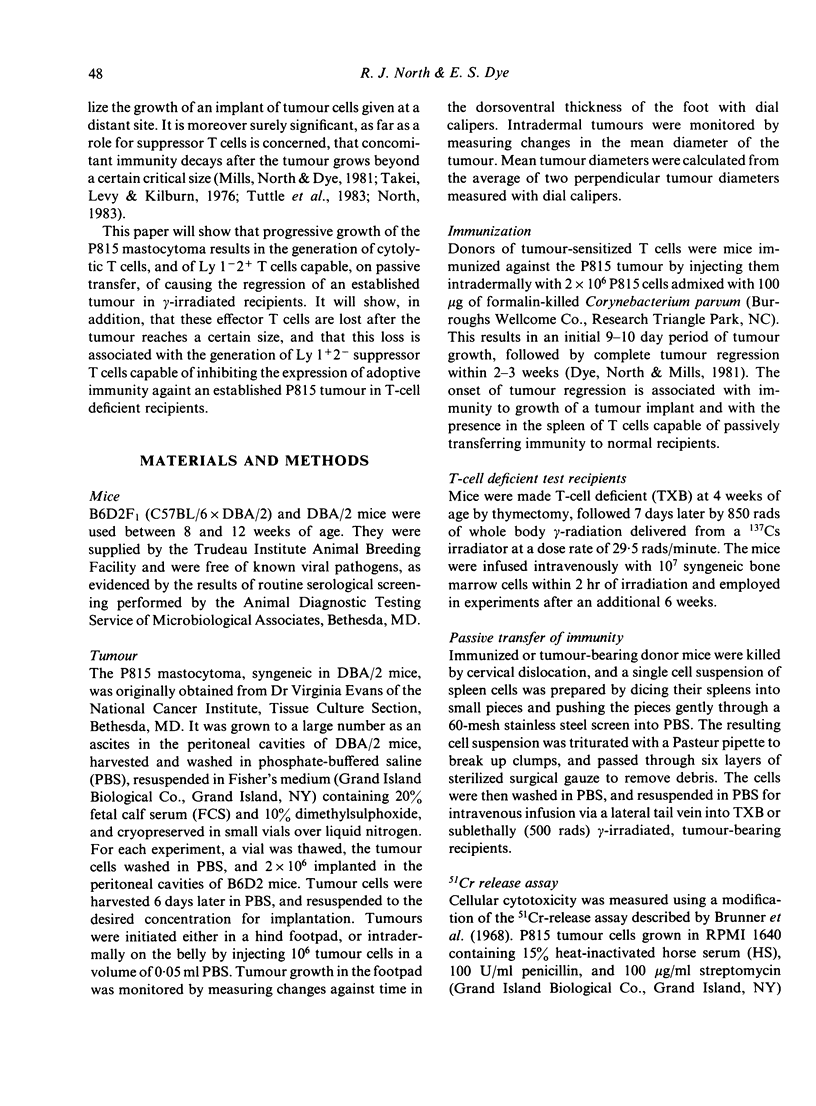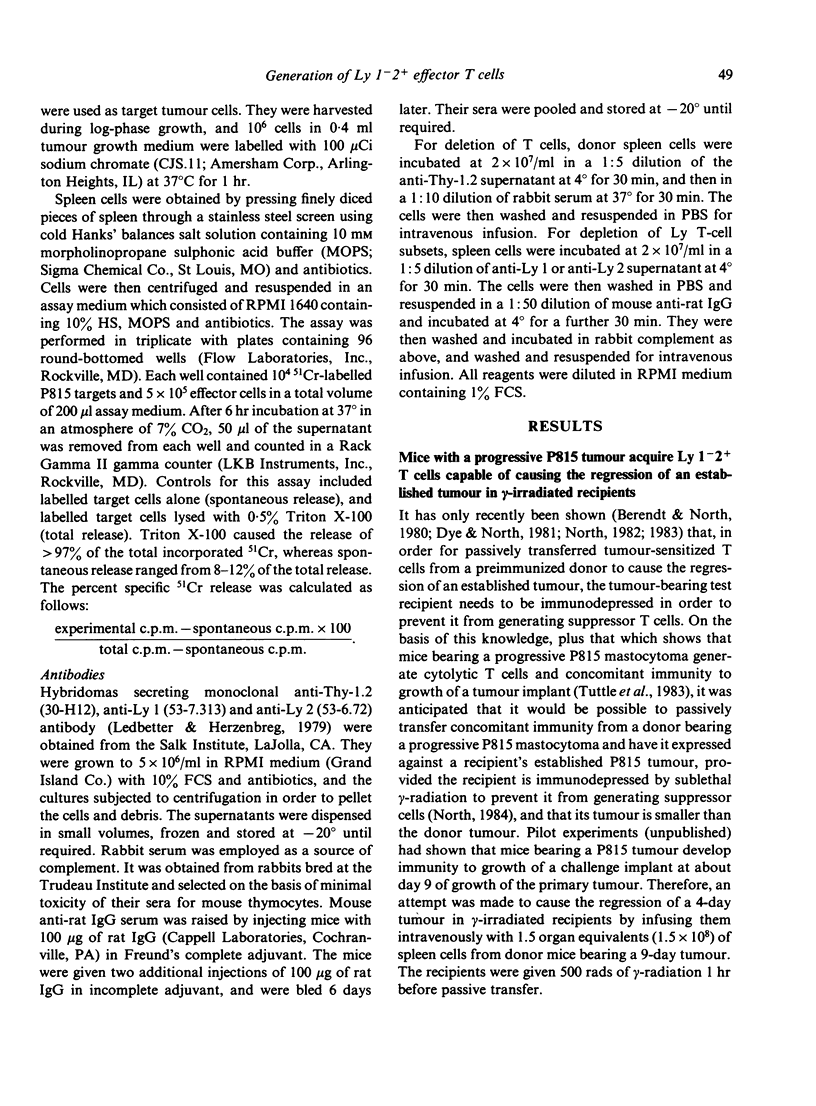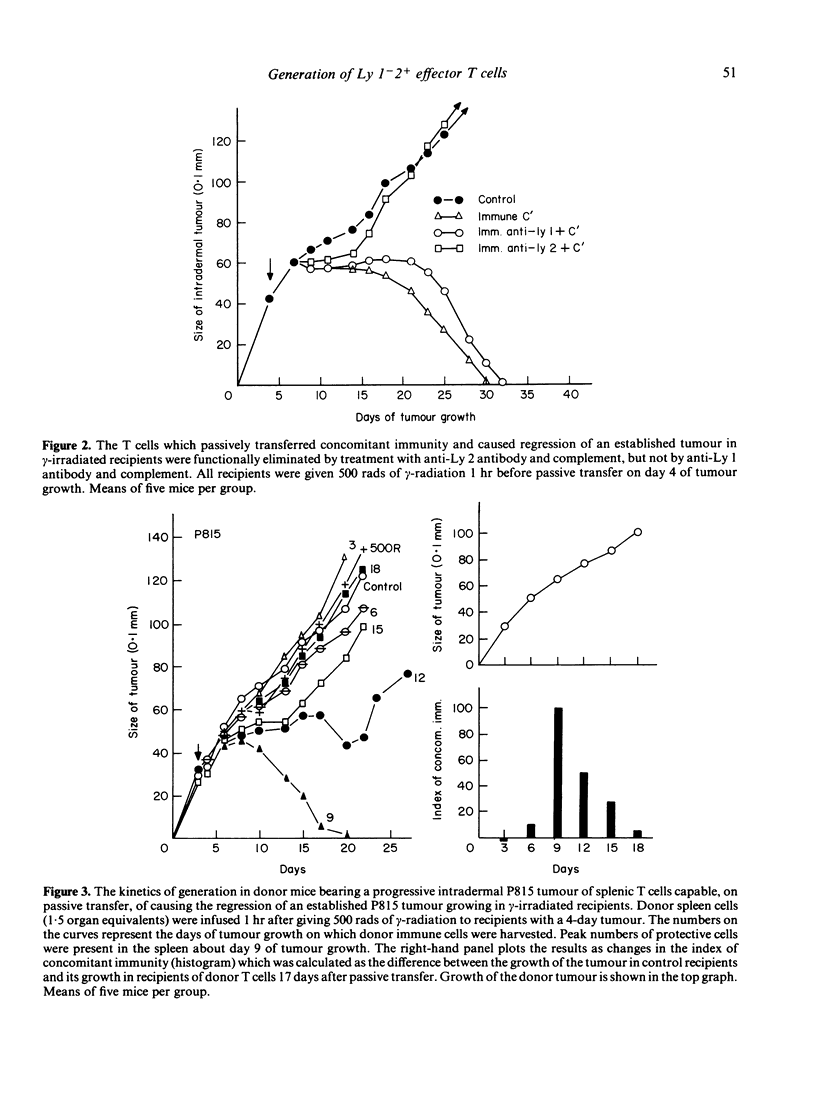Abstract
It has been shown that progressive growth of the P815 mastocytoma in its semisyngeneic B6D2 host results, between days 6 and 9 of tumour growth, in the generation of Ly 1-2+ T cells which are capable, on passive transfer, of causing the regression of an established tumour in gamma-irradiated recipients, and of T cells which are capable of lysing P815 tumour cells in vitro. After 9 days of tumour growth, these effector T cells are progressively lost; this is associated with the progressive acquisition of Ly 1+2- suppressor T cells which are capable of inhibiting the expression of passively transferred immunity against an established tumour in T-cell deficient recipients. The results are consistent with the hypothesis that this P815 mastocytoma grows progressively, in spite of its immunogenicity, because it evokes the generation of suppressor T cells before enough effector T cells are generated to reject it.
Full text
PDF









Selected References
These references are in PubMed. This may not be the complete list of references from this article.
- Benacerraf B., Greene M. I., Sy M. S., Dorf M. E. Suppressor T cell circuits. Ann N Y Acad Sci. 1982;392:300–308. doi: 10.1111/j.1749-6632.1982.tb36115.x. [DOI] [PubMed] [Google Scholar]
- Berendt M. J., North R. J. T-cell-mediated suppression of anti-tumor immunity. An explanation for progressive growth of an immunogenic tumor. J Exp Med. 1980 Jan 1;151(1):69–80. doi: 10.1084/jem.151.1.69. [DOI] [PMC free article] [PubMed] [Google Scholar]
- Biddison W. E., Palmer J. C. Development of tumor cell resistance to syngeneic cell-mediated cytotoxicity during growth of ascitic mastocytoma P815Y. Proc Natl Acad Sci U S A. 1977 Jan;74(1):329–333. doi: 10.1073/pnas.74.1.329. [DOI] [PMC free article] [PubMed] [Google Scholar]
- Brunner K. T., Mauel J., Cerottini J. C., Chapuis B. Quantitative assay of the lytic action of immune lymphoid cells on 51-Cr-labelled allogeneic target cells in vitro; inhibition by isoantibody and by drugs. Immunology. 1968 Feb;14(2):181–196. [PMC free article] [PubMed] [Google Scholar]
- Dye E. S., North R. J. Adoptive immunization against an established tumor with cytolytic versus memory T cells. Immediate versus delayed onset of regression. Transplantation. 1984 Jun;37(6):600–605. doi: 10.1097/00007890-198406000-00015. [DOI] [PubMed] [Google Scholar]
- Dye E. S., North R. J., Mills C. D. Mechanisms of anti-tumor action of Corynebacterium parvum. I. Potentiated tumor-specific immunity and its therapeutic limitations. J Exp Med. 1981 Sep 1;154(3):609–620. doi: 10.1084/jem.154.3.609. [DOI] [PMC free article] [PubMed] [Google Scholar]
- Dye E. S., North R. J. T cell-mediated immunosuppression as an obstacle to adoptive immunotherapy of the P815 mastocytoma and its metastases. J Exp Med. 1981 Oct 1;154(4):1033–1042. doi: 10.1084/jem.154.4.1033. [DOI] [PMC free article] [PubMed] [Google Scholar]
- Eardley D. D., Kemp J., Shen F. W., Cantor H., Gershon R. K. Immunoregulatory circuits among T cell sets: effect of mode of immunization on determining which Lyl T cell sets will be activated. J Immunol. 1979 May;122(5):1663–1665. [PubMed] [Google Scholar]
- Eggers A. E., Wunderlich J. R. Suppressor cells in tumor-bearing mice capable of nonspecific blocking of in vitro immunization against transplant antigens. J Immunol. 1975 May;114(5):1554–1556. [PubMed] [Google Scholar]
- Elmets C. A., Bergstresser P. R., Tigelaar R. E., Wood P. J., Streilein J. W. Analysis of the mechanism of unresponsiveness produced by haptens painted on skin exposed to low dose ultraviolet radiation. J Exp Med. 1983 Sep 1;158(3):781–794. doi: 10.1084/jem.158.3.781. [DOI] [PMC free article] [PubMed] [Google Scholar]
- FOLEY E. J. Antigenic properties of methylcholanthrene-induced tumors in mice of the strain of origin. Cancer Res. 1953 Dec;13(12):835–837. [PubMed] [Google Scholar]
- Fujimoto S., Greene M. I., Sehon A. H. Regualtion of the immune response to tumor antigens. I. Immunosuppressor cells in tumor-bearing hosts. J Immunol. 1976 Mar;116(3):791–799. [PubMed] [Google Scholar]
- Gorelik E. Concomitant tumor immunity and the resistance to a second tumor challenge. Adv Cancer Res. 1983;39:71–120. doi: 10.1016/s0065-230x(08)61033-7. [DOI] [PubMed] [Google Scholar]
- Holán V., Mitchison N. A. Haplotype-specific suppressor T cells mediating linked suppression of immune responses elicited by third-party H-2 alloantigens. Eur J Immunol. 1983 Aug;13(8):652–657. doi: 10.1002/eji.1830130809. [DOI] [PubMed] [Google Scholar]
- Ledbetter J. A., Herzenberg L. A. Xenogeneic monoclonal antibodies to mouse lymphoid differentiation antigens. Immunol Rev. 1979;47:63–90. doi: 10.1111/j.1600-065x.1979.tb00289.x. [DOI] [PubMed] [Google Scholar]
- Liew F. Y., Hale C., Howard J. G. Immunologic regulation of experimental cutaneous leishmaniasis. V. Characterization of effector and specific suppressor T cells. J Immunol. 1982 Apr;128(4):1917–1922. [PubMed] [Google Scholar]
- Macphail S., Stutman O. Suppressor T cells activated in a primary in vitro response to non-major histocompatibility alloantigens. J Exp Med. 1982 Nov 1;156(5):1398–1414. doi: 10.1084/jem.156.5.1398. [DOI] [PMC free article] [PubMed] [Google Scholar]
- Mills C. D., North R. J., Dye E. S. Mechanisms of anti-tumor action of Corynebacterium parvum. II. Potentiated cytolytic T cell response and its tumor-induced suppression. J Exp Med. 1981 Sep 1;154(3):621–630. doi: 10.1084/jem.154.3.621. [DOI] [PMC free article] [PubMed] [Google Scholar]
- Mills C. D., North R. J. Expression of passively transferred immunity against an established tumor depends on generation of cytolytic T cells in recipient. Inhibition by suppressor T cells. J Exp Med. 1983 May 1;157(5):1448–1460. doi: 10.1084/jem.157.5.1448. [DOI] [PMC free article] [PubMed] [Google Scholar]
- Naor D. Suppressor cells: permitters and promoters of malignancy? Adv Cancer Res. 1979;29:45–125. doi: 10.1016/s0065-230x(08)60846-5. [DOI] [PubMed] [Google Scholar]
- North R. J., Bursuker I. Generation and decay of the immune response to a progressive fibrosarcoma. I. Ly-1+2- suppressor T cells down-regulate the generation of Ly-1-2+ effector T cells. J Exp Med. 1984 May 1;159(5):1295–1311. doi: 10.1084/jem.159.5.1295. [DOI] [PMC free article] [PubMed] [Google Scholar]
- North R. J. Cyclophosphamide-facilitated adoptive immunotherapy of an established tumor depends on elimination of tumor-induced suppressor T cells. J Exp Med. 1982 Apr 1;155(4):1063–1074. doi: 10.1084/jem.155.4.1063. [DOI] [PMC free article] [PubMed] [Google Scholar]
- North R. J. Gamma-irradiation facilitates the expression of adoptive immunity against established tumors by eliminating suppressor T cells. Cancer Immunol Immunother. 1984;16(3):175–181. doi: 10.1007/BF00205425. [DOI] [PMC free article] [PubMed] [Google Scholar]
- North R. J. The murine antitumor immune response and its therapeutic manipulation. Adv Immunol. 1984;35:89–155. doi: 10.1016/s0065-2776(08)60575-1. [DOI] [PubMed] [Google Scholar]
- Rolink A. G., Gleichmann E. Allosuppressor- and allohelper-T cells in acute and chronic graft-vs.-host (GVH) disease. III. Different Lyt subsets of donor T cells induce different pathological syndromes. J Exp Med. 1983 Aug 1;158(2):546–558. doi: 10.1084/jem.158.2.546. [DOI] [PMC free article] [PubMed] [Google Scholar]
- Small M., Trainin N. Separation of populations of sensitized lymphoid cells into fractions inhibiting and fractions enhancing syngeneic tumor growth in vivo. J Immunol. 1976 Jul;117(1):292–297. [PubMed] [Google Scholar]
- Takei F., Levy J. G., Kilburn D. G. In vitro induction of cytotoxicity against syngeneic mastocytoma and its suppression by spleen and thymus cells from tumor-bearing mice. J Immunol. 1976 Feb;116(2):288–293. [PubMed] [Google Scholar]
- Tuttle R. L., Knick V. C., Stopford C. R., Wolberg G. In vivo and in vitro antitumor activity expressed by cells of concomitantly immune mice. Cancer Res. 1983 Jun;43(6):2600–2605. [PubMed] [Google Scholar]


